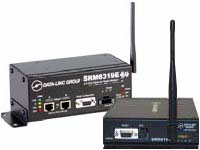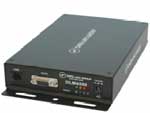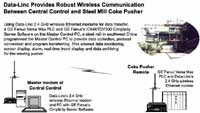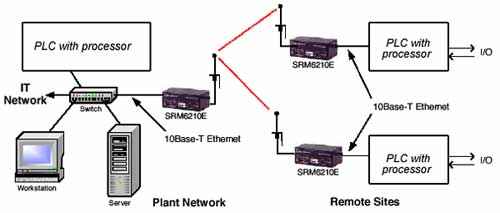|
|
||||
|
||||
|
News & Events
Insight Contents New Products: Case Studies: Tutorial: Wireless Ethernet for Industrial Networks |
Current Issue
New Products
|
|||||||||
|
Data-Linc's SRM 2.4 GHz modems, the SRM6100-EU serial radio and the SRM6310E-EU wireless Ethernet modems, have receive approval for use in European Union counties. Both of these -EU versions, designed to meet European CE Mark and ETSI RF regulations, combine advanced frequency hopping technology and a highly sensitive RF receiver to maximize transmission range and industrial performance.
See the data sheets for the SRM6100-EU and SRM6310E-EU specifications.
DLM4500 extended temperature Dial-up/Leased line Modem
|
||||||
PlantLincTM stand-alone short to medium range modem and industrial wireless I/O extender
our long range, robust SRM6100. PlantLinc 5000, which also operates in the license-free 902–928 MHz band, supports point-to-point and point-to- multipoint architectures, has a built-in Repeater mode for working around obstructions and supports data rates up to 38.4 Kbps. It comes in a standard small, rugged DIN rail mountable metal enclosure. See the PLR5000 data sheet for more information. The other member of the PlantLinc Family is the PLR 580 Industrial Wireless I/O Extender which also operates in the 900 MHz license-free band. PlantLinc 580 features a cost effective wireless discrete and analog signal extender that is field configurable and easy to implement— automatic start and restart. The PLR 580 has the same maximum range as the PLR 5000, has Repeater available to communicate around obstructions, supports point-to-point or point-to-multipoint configurations and utilizes robust frequency hopping technology resulting in excellent noise immunity. See the PLR580 data sheet for more information. |
||||||
| ^ Top of Page ^ |
Case StudiesGE Fanuc
|
|
Rockwell Automation
Data-Linc's SRM license-free modems selected to interface with Allen-Bradley PLCs for extensive pipeline applications in Brazil
|
Schneider
|
|
Siemens
Data-Linc Helps Ensure Clean, Safe Water for the People of Queretaro State, Mexico
|
|
Diagram 1: Example of a wireless Ethernet network using explicit messaging. The network supports PLC programming, data collection and SCADA functions. Ethernet also supports direct I/O communication serving the role of a fieldbus over Ethernet cabling. In this mode, implicit messaging is used to directly communicate from the PLC program to the I/O device via the Ethernet network. The Ethernet network effectively serves as the communication infrastructure for distributed I/O. Because Ethernet was not intended to be deterministic (having guaranteed response times), PLC manufacturers have established network design recommendations to achieve a high degree of deterministic performance. Following these guidelines essentially ensure that the Ethernet segment is as fast as possible (e.g. Full Duplex 100Base-T) and that unnecessary network traffic is kept to a minimum. Wireless presents two concerns for use in deterministic I/O systems: data transmission rate and latency. First, wireless Ethernet systems cannot achieve the throughput of a Full Duplex 100Base-T segment. Emerging wireless technologies may eventually address this, but they are unproven at this time especially in industrial environments. Secondly, industrial wireless systems must contend with interference and retransmit packets when necessary. Error correction ensures that data packets are successfully received, but causes variability in message timing which negates high degree determinism. Direct sequence RF (e.g. IEEE 802.11b) has the best chance of predictable message timing, but direct sequence is not always ideal for factory floor communications due to interference susceptibility. Frequency hopping RF offers the highest level of interference immunity, but can have substantial latency and packet delay times. Wireless Ethernet may be an ideal communication method for I/O if the system function and performance expectations are carefully considered. For example, if the I/O system is for data acquisition for machine monitoring purposes, then true determinism may not be needed and wireless quite appropriate. Similarly if the I/O is used for non-critical control, wireless may be acceptable. However if I/O timing is critical or safety mechanisms are dependent, then wireless is inappropriate. |
|
|
Diagram 2: Example of a wireless Ethernet network using implicit messaging for non-critical data acquisition and control. A fundamental trade-off in any wireless modem is range and data rate. Data-Linc Group has modems that offer very long range (25+ miles with standard antennas) at modest data rates (100 Kbps) or shorter range (2- 5 miles, depending on antenna) at high data rates (1 to 6 Mbps). The SRM family of long-range, frequency hopping modems provide an exceptionally high level of noise/interference immunity in all operating conditions. The FastLinc 810E (Access point) and 800C (PCMCIA card) have maximum 802.11b data throughputs with typically twice the range of other products of its type. The FastLinc 810E can also be configured as a wireless bridge. All Data-Linc modems are packaged in heavy gauge steel, have extended operating temperatures and can be connected to a wide variety of antennas and cable lengths for use in challenging factory floor or severe outdoor operating conditions. Data-Linc has extensive expertise in PLCs, HMIs, Drives and Ethernet. We provide both extensive pre- and post-sale technical support and commonly pre-configure modems for our customers. Contact us at 425-882-2206 or info@data-linc.com to learn more about our wireless Ethernet products and capabilities in industrial applications. |
|
| ^ Top of Page ^ |
FAQ
|
| ^ Top of Page ^ | ||
|
|
||
| Products |
Features & Benefits | Focus Item | Product Selection Guides | Catalog | PDF Library | Order Information | FAQ | |
| Tech Resources |
Engineering Specifications | Articles & Technical Papers | Installation Information | |
| Partners |
GE Fanuc | Omron | Rockwell Automation | Schneider Electric | Siemens | Technology Partners | |
| Industries |
Security | Traffic | and other industry application notes and diagrams | |
| Sales Channels |
Distributors | System Integrators | OEMs | |
| News |
Tradeshows and Events | Press Releases | Newsletters | |
| About Us |
Overview | Jobs/Employment | Office Locations/Contact Information | |
|
|
||
| © 1996-2008 Data-Linc Group. All rights reserved. | ||
| 50303 |
















